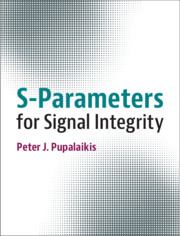Book contents
- Frontmatter
- Dedication
- Contents
- Preface
- Abbreviations
- Introduction
- Part I Scattering Parameters
- Part II Applications
- Part III Signal Processing and Measurement
- Part IV SignalIntegrity
- Appendix A Terminology and Conventions
- Appendix B Telegrapher’s Equations
- Appendix C Matrix Algebra
- Appendix D Symbolic Device Solutions
- References
- Index
- References
References
Published online by Cambridge University Press: 18 January 2020
- Frontmatter
- Dedication
- Contents
- Preface
- Abbreviations
- Introduction
- Part I Scattering Parameters
- Part II Applications
- Part III Signal Processing and Measurement
- Part IV SignalIntegrity
- Appendix A Terminology and Conventions
- Appendix B Telegrapher’s Equations
- Appendix C Matrix Algebra
- Appendix D Symbolic Device Solutions
- References
- Index
- References
- Type
- Chapter
- Information
- S-Parameters for Signal Integrity , pp. 631 - 635Publisher: Cambridge University PressPrint publication year: 2020



